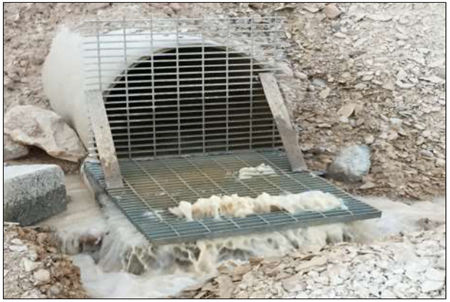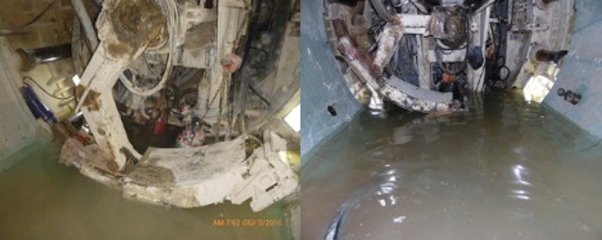Author: Raquel Macedo Moreira
Tutor: Ing. Giovanni Franchi
Master: Contract, Claim and delay management in construction works, a.a. 2022/23
This master thesis delved into one noteworthy challenge encountered during a high value construction project in Saudi Arabia for the construction of a wastewater conveyor tunnel. The project consisted of the employment of a double shield tunnel boring machine (TBM) to excavate two tunnels and simultaneously line those tunnels from the inside of the TBM during the excavation process. Such an approach was intended to optimize efficiency, reduce construction timelines, and ensure the structural integrity of the tunnel. However, the project encountered a substantial issue and the original plan fell through when, during the excavation of the first tunnel, the TBM encountered an overwhelming inflow of underground water.
The cascading effects of the damage caused by the exorbitant amount of water encountered by the TBM during the excavation were enormous. The list of deriving problems included the slow progress of the TBM excavations, the complications with the segment erection activities once the water filled the lower level of all machinery inside the tunnel, the challenges of carrying out lining activities which could not be performed in contact with water, the unsuitability of the existing method statement to render the tunnel waterproof as required, a generalized delay, and significant additional expenses entailed in the process of dealing with the situation.
Figures 1 and 2 – Water encountered during the excavation of the tunnel
Figure 3 – Cumulative outflows at the tunnel’s portal during TBM excavation
Figures 4 and 5 – Level of water inside the TBM
The case study follows the development of the parties’ dispute from their initial reaction, through the claims presented under the contract, until the final resolution of the dispute in an international arbitration procedure.
As it turned out, a series of factual circumstances of this case led to an inefficient and troublesome resolution process. Issues such as the drafting of the contract, the payment mechanisms established, the structure of the dispute resolution clause, and even the conduct of all involved in the arbitration played a part in complicating the situation, to the detriment of all involved.
Indeed, the journey through this thesis has shed light on the intricate dynamics of negotiating and executing contracts for projects of significant magnitude and complexity.
In the realm of large-scale projects, the stakes are undeniably high. Whether it is the construction of monumental infrastructure, the development of cutting-edge technologies, or the exploration of uncharted territories, these endeavours often entail vast investments of capital, resources, time, and expertise. With such substantial stakes at play, the ramifications of contractual disputes can reverberate far beyond the confines of the negotiating table. Put differently, projects of great proportions can potentially lead to problems of great proportions. From logistical hurdles and difficulties in communication, to unforeseen conditions and an unbalanced contractual framework, a myriad of factors can conspire to complicate the execution of even the most meticulously planned project.
In navigating this landscape, the negotiation of the contract assumes paramount importance. Contracts serve as the linchpin of project governance, delineating rights, responsibilities, and expectations among stakeholders. The negotiated terms, however, must go beyond the mere goal of ‘achieving and agreement’. Instead, they must be properly pondered and adequately balanced so that the terms agreed survive (and are useful) also during the performance of the contract. So that, when a problem arises, there are sufficient resources (and solutions) to the parties in terms of how to avoid or quickly settle their disputes.
Indeed, the process of negotiation demands a meticulous examination of every facet of the project, from technical specifications and deliverables to timelines, milestones, and risk allocation. It necessitates a thorough understanding of the intricacies of the industry, including prevailing standards, best practices, and emerging trends. Moreover, it requires a keen awareness of the legal and regulatory frameworks governing the project, ensuring compliance, and mitigating potential liabilities.
While the prospect of exhaustive deliberation may appear daunting, particularly in the face of pressing deadlines and competing priorities, it is an investment well worth making. The consequences of overlooking crucial details or rushing through negotiations can be dire, often resulting in costly disputes, project delays, and damage to reputations.
In other words, the consideration of the effects of each clause and agreed terms in the long run must outrun whatever need for a speedy negotiation. After all, in the long run, it is better that the lack proper negotiation efforts leads to the lack of an agreement, than to find oneself bound to the terms of a contract that will later impose an unbearable burden onto the weaker party.
Nowhere is this reality more apparent than in the realm of dispute resolution through arbitration. When contractual disagreements escalate to the point of arbitration, the financial toll can be staggering. Multi-million-dollar awards, exorbitant legal fees, and protracted proceedings can drain resources and undermine the viability of even the most lucrative projects.
It is against this backdrop that the industry emphasises the importance and usefulness of predictive modelling contracts and boilerplate clauses. Drawing from collective experience and lessons learned, stakeholders have sought to anticipate potential challenges and pre-emptively address them through standardized provisions. These boilerplate clauses serve as invaluable tools in streamlining negotiations, enhancing clarity, and reducing ambiguity. Likewise, they also provide for empirically proved to be efficient methods of dispute resolution that should not be taken for granted in complex contract negotiations in the construction industry.
However, the efficacy of boilerplate clauses hinges upon their informed application. While they provide a valuable starting point, they must be tailored to the unique circumstances of each project and subject to rigorous scrutiny. FIDIC provides a great example for that by having different sets of contractual frameworks recommended for different types of projects. The blind incorporation of pre-existing templates without due diligence can invite unforeseen risks and undermine the very objectives they are meant to achieve.
In essence, the lessons learned from the case hereby mentioned underscore the importance of foresight and diligence in contract negotiations and performance. A contract performance that could have been leveraged by industry expertise, the embrace of best practices, and the heeding the lessons of past disputes, was instead a collection of unfitting and unclear contractual provisions which instead of assisting the resolution of the parties’ disagreements, contributed to the polarization of the parties’ positions and to the exponential escalation of the dispute.
The true measure of success lies not only in the execution of contracts but also in the foresight exercised in their crafting. That is the reason why it is imperative to insist on a commitment to prudent negotiation practices and de-escalating approach to dispute resolution, recognizing that the path to success is paved with careful consideration, collaboration, and informed decision-making.





